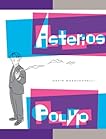 Well, crap. I just wrote a whole, long beautiful review of this and it DISAPPEARED. For no apparent reason. I'm mad and sad at the same time. But I'll try to recreate to the best of my ability...
Well, crap. I just wrote a whole, long beautiful review of this and it DISAPPEARED. For no apparent reason. I'm mad and sad at the same time. But I'll try to recreate to the best of my ability...This is an incredible book. And I don't mean, "incredible for a comic book." While it is a graphic novel, Asterios Polyp is a better book than 80% of the prose books I've ever read in my life.
It's a fairly simple story when boiled down to its basics. A man, our hero Asterios, has a broken heart, and it's really his own fault. So he's depressed and miserable. Then he goes through some mental and spiritual rejuvenation in a small town where he happens to get off the bus. And then he goes and tries to get back his girl.
The genius of the book is in its construction. Everything is laid out in dualities. The book uses two main colors, as you can see from the cover image. The story is told in segments alternating between the present and the past. The narrator is not Asterios himself, but his twin brother Ignazio - who died at birth. And there is imbedded in the story some literal discussion of duality in architecture and design, in art, in science, in human nature, in the universe. Layered on top of all of this duality is the Greek tragedy of Orpheus and Eurydice, acted out in the persons of Asterios and his love, Hana, and also making a literal appearance in the story when Hana becomes involved in an actual production of Orpheus, the musical. Add to all of this some insights into the nature of architecture and design, told in a story constructed in an architectural manner and through artwork that is the epitome of good design, and you have a pretty complexly constructed book.
That brings me to the art. The very colors used in each scene are weighted with meaning. In a book where even the colors have such significance, you can guess how important the rest of the artwork is. It's very modern - in a late-'50s/early-'60s kind of way - and very focused on high design. The lines used to draw the characters are frequently used to give the reader insight into their personalities, even when they are minor characters. I have never read a book where the art was so important to understanding the moods, personalities, even souls of the characters.
This book was just amazing. It touched my heart; it made me think; it made me laugh; it made me slow down and study the art; it's stayed with me for weeks. I want to read it at least 10 more times in my life. And I'd highly recommend anyone else do the same. I'd give it 6 of 5 stars if that were possible.
Okay, Jen. You got me. I am, as a rule, totally uninterested in graphic novels, but now I am intrigued....off to hunt down a copy! Go you!
ReplyDeleteYay! I win at book reviewing!
ReplyDelete